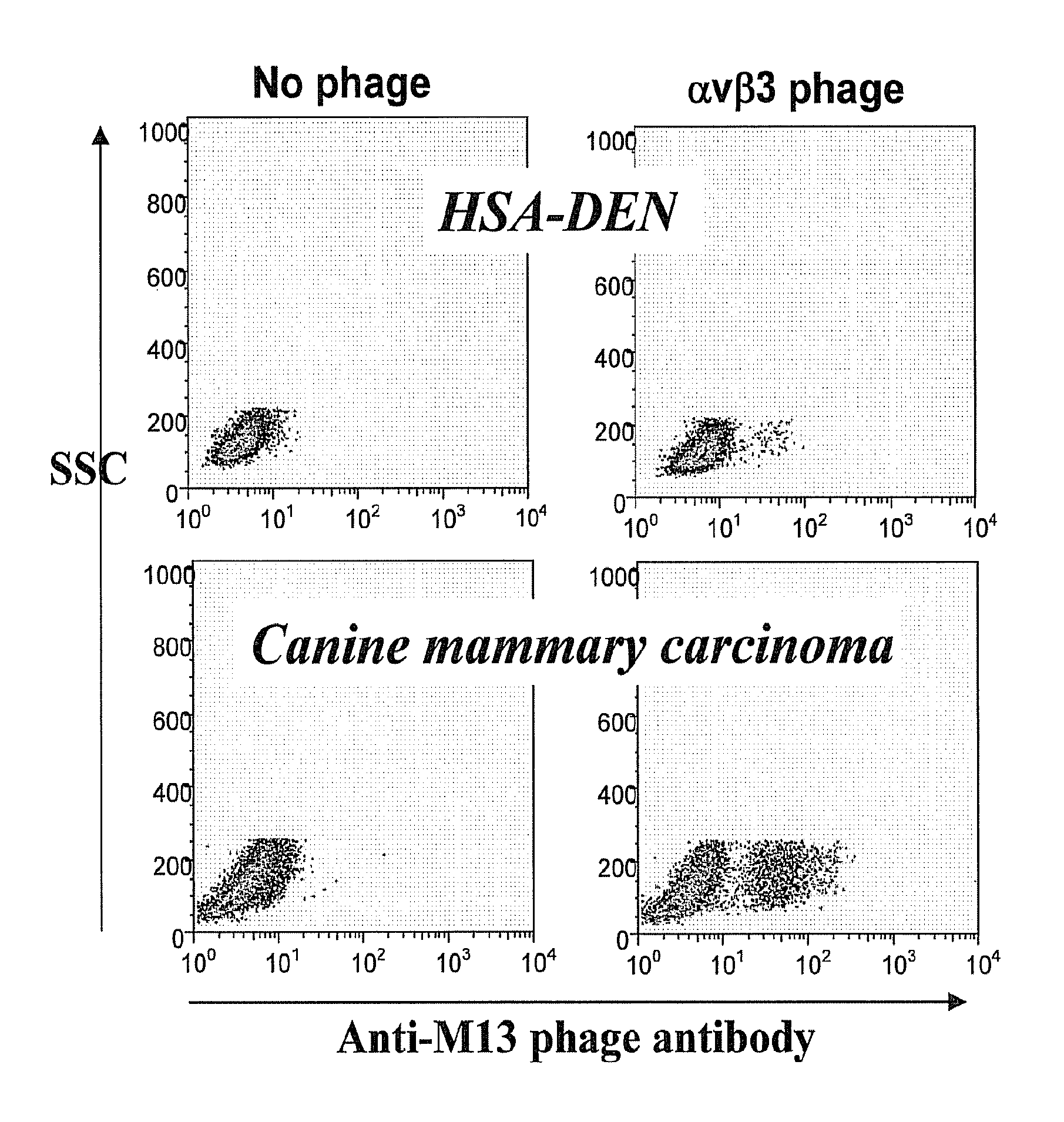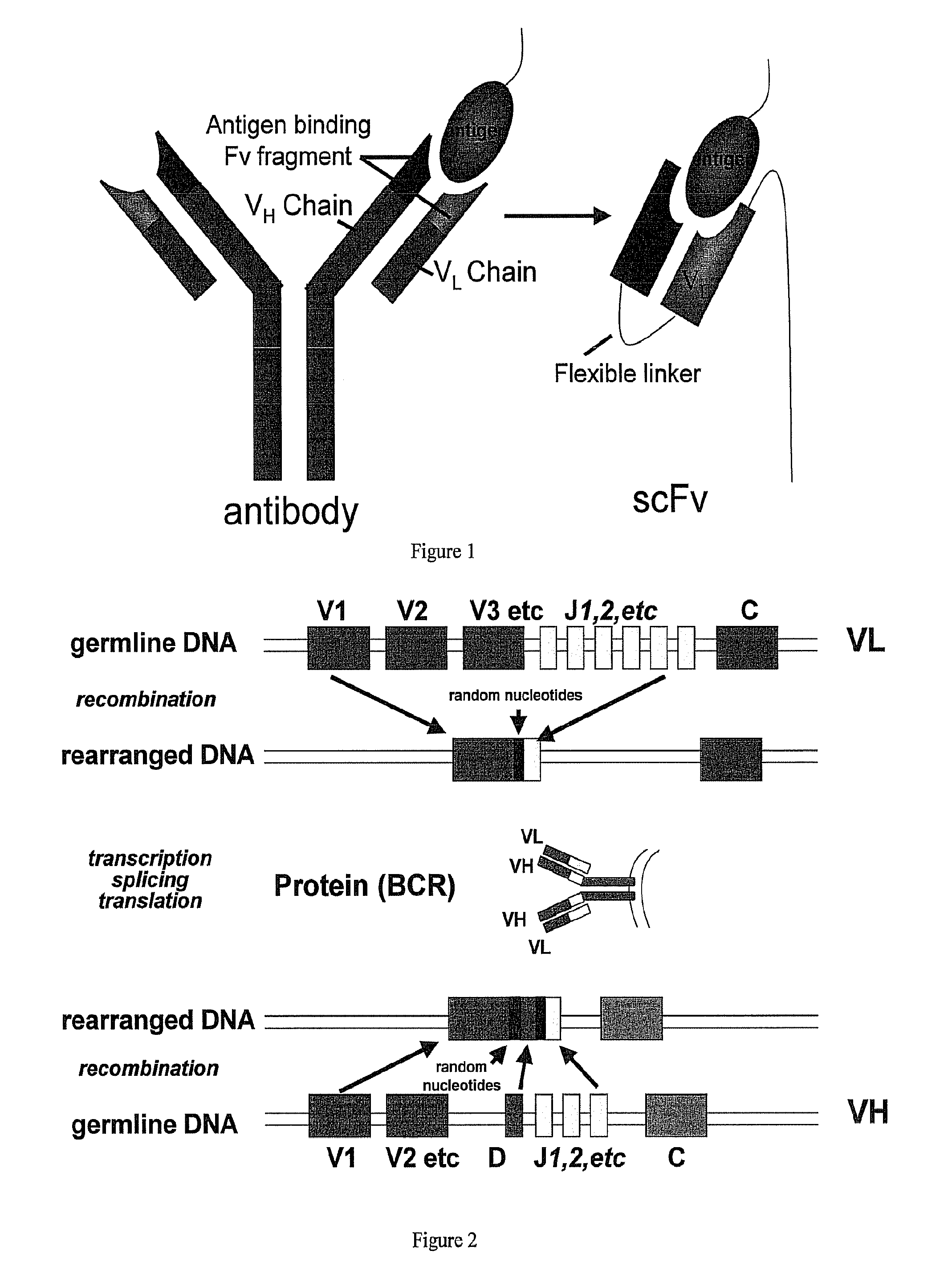Single chain fragment variable antibody libraries and uses thereof
a single-chain fragment, antibody technology, applied in the field libraries of antibody variable domains or antibodies, can solve the problems of reducing the overall efficacy of the treatment, and reducing the number of patients
- Summary
- Abstract
- Description
- Claims
- Application Information
AI Technical Summary
Benefits of technology
Problems solved by technology
Method used
Image
Examples
example 1
Design of Degenerate PCR Primers to Generate Single Chain Fragment Variable Antibodies for Targeted Therapy in the Dog
[0147]A set of degenerate primers that are intended to amplify all known VH and VL (lambda and kappa) chains were designed based on predicted nucleotide sequences and back translated protein sequences. The primers consist of 7 VH forward primers and a single reverse VH primer, located in the constant IgG region such that all amplified VH chains are from the antigen-experienced repertoire (ie IgG). Also designed, were 13 VL lambda forward primers and 2 VL lambda reverse primers that amplify the canine VL lambda chain repertoire and 4 VL kappa forward and 4 VL kappa reverse primers that amplify the canine VL kappa chain repertoire. These primers were shown to reliably amplify VH and VL IgG chains from canine lymphocyte cDNA and that generated amplicons can be “sewn” together using a second PCR reaction to generate scFv constructs. These constructs have been cloned into...
example 2
Generation of Phage Display Combinatorial Antibody Libraries from Dogs with Hemangiosarcoma (HSA)
[0157]In order to recapitulate the immune repertoire of dogs with HSA and screen it for tumor-specific antibody responses scFv libraries are generated from splenic lymphocytes of dogs with HSA. Spleen samples are obtained from all canine patients that are undergoing splenectomy for the treatment of suspected HSA. All samples are taken at the time of surgery, divided and placed into RNA later, STD media and formalin. Histopathology is used to confirm or refute the working diagnosis of HSA. Samples in STD media are immediately processed into single cell suspensions, cryopreserved and banked at the PennVet Tumor Tissue Bank. Samples in RNA are then stored at −80° C. until the diagnosis of HSA is confirmed. Splenic samples are collected from 10 dogs with HSA and 10 dogs with non-neoplastic splenic disease (e.g. hematoma, torsion etc). RNA is isolated from the spleens of dogs with HSA using t...
example 3
Identification of Tumor-Specific scFv of Canine Origin that Bind Specifically to Canine HSA Cell Lines
[0160]Whole cell panning techniques are used to identify scFv constructs expressed by phage that specifically bind to antigens expressed by malignant endothelial cells. The use of whole cell panning techniques enables the isolation of tumor specific scFv binders without the necessity of TAA identification.
[0161]To minimize non-specific selection of phage, scFv phage display libraries from each dog with HSA undergo three rounds of subtractive panning against non-neoplastic allogeneic canine spleen cells (obtained from dogs that underwent splenectomy for non-malignant splenic disease e.g. torsion, hematoma). Negatively selected phage are then incubated with single cell suspensions of autologous HSA cell lines generated from cryopreserved cell suspensions. Cell cultures are washed in PBS / 1% FCS 5-8 times to remove unbound phage. Bound phage is then eluted from the malignant target cell...
PUM
| Property | Measurement | Unit |
|---|---|---|
| dissociation constant | aaaaa | aaaaa |
| dissociation constant | aaaaa | aaaaa |
| dissociation constant | aaaaa | aaaaa |
Abstract
Description
Claims
Application Information
 Login to view more
Login to view more - R&D Engineer
- R&D Manager
- IP Professional
- Industry Leading Data Capabilities
- Powerful AI technology
- Patent DNA Extraction
Browse by: Latest US Patents, China's latest patents, Technical Efficacy Thesaurus, Application Domain, Technology Topic.
© 2024 PatSnap. All rights reserved.Legal|Privacy policy|Modern Slavery Act Transparency Statement|Sitemap



